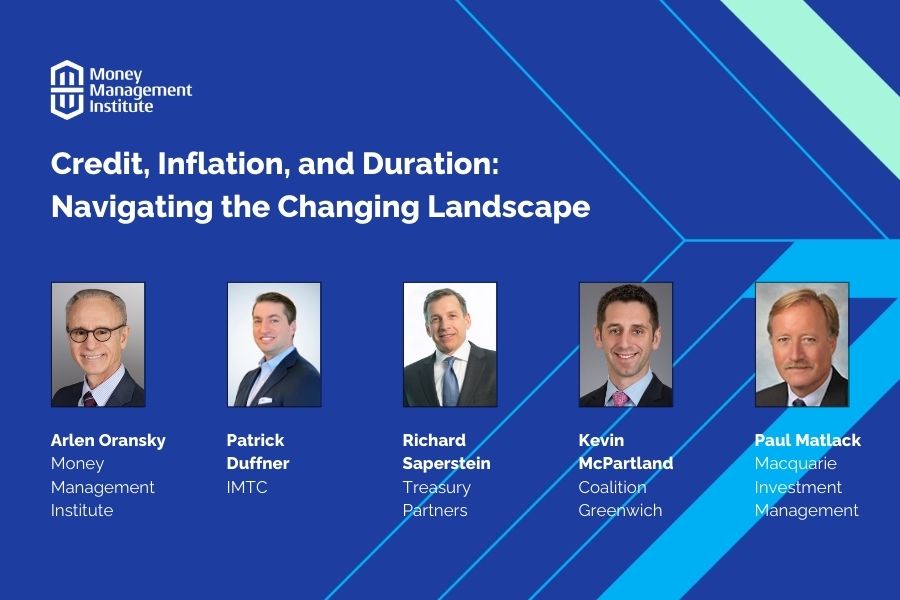Over the past year, fixed income markets have taken center stage, attracting the keen attention of asset and wealth managers. What was once viewed by some as “uninvestable” due to near zero interest rates of the past decade has re-emerged as a true source of yield in any portfolio. Against a backdrop of evolving economic conditions, rising interest rates, and central bank policies, fixed income markets have become interesting again!
In this blog, we delve into the key takeaways from a recent webinar from the Money Management Institute (MMI) featuring seasoned experts:
- Paul Matlack, Senior Fixed Income Portfolio Manager/Strategist, Macquarie Investment Management
- Kevin McPartland, Head of Market Structure and Technology Research, Coalition Greenwich
- Richard Saperstein, Managing Director, Principal, Chief Investment Officer, Treasury Partners
- Moderation: Patrick Duffner, Head of Business Development, IMTC
They shared their insights and analyses of the current fixed income landscape, exploring the trends, concerns, and strategies that are shaping the market’s trajectory.
Impending likelihood of an economic slowdown
The general consensus on the webinar was around the likelihood of an economic slowdown, a topic of significant concern in the current fixed income market landscape. The Federal Reserve’s actions, including the timing of rate adjustments and quantitative tightening, will play a crucial role in shaping the economic landscape.
Richard Saperstein, CIO of Treasury Partners expands upon the factors driving a slowdown: “The classic driver is the increase in Fed funds but running in the background is QT, quantitative tightening, which is draining reserves on the system at the same time.” He adds that leading economic indicators (LEI) have been declining for over a year and combined with a host of other variables including M2 contracting at a steep rate, student loan repayments, commercial real estate loans, bank lending contracting, bankruptcies up and more, “so there’s a very significant underlying tow of indicators pointing to a slowdown right now.”
He adds: “The biggest conflict that bond investors are going to face is going to be the fact that the federal government’s running a very significant budget deficit and will have to continue to add Treasuries. And if you assume the average cost of capital is in the 5% range, that’s going to only expand their budget deficit going forward, requiring them to add more Treasuries. So, the question really becomes, will more supply of Treasuries on the market overwhelm a slowing economy, which would normally precipitate lower interest rates? I think that’s going to be the big question. That has to be resolved for bond investors over the next 12 to 24 months.“
Looking globally, Paul Matlack adds that China and Europe, particularly Germany, are slowing down which should be taken into consideration, though overall “it’s probably not going to be as steep a downturn as we once thought.”
However, as Kevin McPartland remarks, the market doesn’t seem to be adequately worried about the potential for a slowdown.
Where are interest rates headed?
On the future trajectory of interest rates, the panelists were in consensus that while near-term rate increases are plausible, the Fed Funds Rate is close to its terminal rate in this cycle and most likely will see a reduction in rates in the medium term. A poll on whether the Fed funds will be cut to under 2% before 2026 revealed that 81% do not believe that will happen.
Paul Matlack opines that the most significant risk coming up is that “the Fed is going to err on the side of really wanting to kill inflation. And by doing that, they run the risk of staying too high too long.” If they wait too long to pause or cut rates, wanting clear evidence inflation has been controlled, that’s where a harder downturn will occur. However, given “the resiliency of employment, the liquidity of most corporate balance sheets, the relative health of bank balance sheets and to me that the higher probability now, is for a softer landing.”
Emphasis on quality and extending duration
A recurring theme emphasized was the paramount importance of high-quality bonds and the extension of duration in fixed income portfolios. Matlack explains that “we came in short, we’re now lengthening. Again, we think we’re near a cyclical peak and rates and we think that makes sense. Definitely favoring higher quality whether it’s on taxable or munis.”
While “the flows into money market funds have just been pretty incredible. And it continues till now, just more and more money flowing in there,” adds McPartland. “It’s time to take the money out of cash and lock in those rates for the longer term.”
Saperstein emphasized the importance of extending duration as a strategy for capturing potential upside in a slowing economy with lower interest rates: “I want to get out past this immediate cycle, where we are now and get into a bond investment where duration can lead to appreciation.”
Attractiveness of SMAs and ETFs
One of the intriguing trends discussed in the webinar was the rise of separately managed accounts (SMAs), alongside the existing rise in ETFs, in the fixed income landscape. The panelists noted that there has been a noticeable growth in SMAs, reflecting the increasing demand for customized and tailored investment solutions that are tax efficient. Richard discusses that Treasury Partners manages money in SMAs and that they’re “seeing a growth in assets, really across our entire book.”
McPartland adds that across the different investment vehicles, “ETFs obviously win on the ease front, SMAs win on the customization front and tax benefits.” And that the growth in the electronification and automation of the bond market was driven a lot by the rise in ETFs but has also led to “the bond market being more transparent. There’s a lot more data available today on the bond markets than there was 5-10 years ago. The bond market being more electronic and providing more access, has sort of arguably made the market more liquid.”
SMAs have become a popular choice among investors seeking greater flexibility and control over their fixed income portfolios. This shift towards SMAs underscores the importance of individualized investment strategies that can adapt to a rapidly changing market environment, providing investors with opportunities to navigate the intricacies of the fixed income markets more effectively.
Saperstein adds that “one of the ways that we are navigating that [growth] is we recently adopted the IMTC portfolio management software, which enables us to be much more efficient and accurate in running multiple portfolios and different strategies.”
Want to learn more about our portfolio management software? Read more here.
Conclusion
The MMI webinar brought to the fore a rich tapestry of insights and analyses from seasoned experts, shedding light on the nuances of today’s fixed income markets. The most pressing concerns are around the likelihood of an economic slowdown and the direction of rates from the Fed. Asset and wealth managers are generally looking to high quality and extending duration to capitalize on yields for their clients. And the rise in both SMAs and ETFs have increased options for investing in the market – customization and tax benefits for SMAs and transparency and ease for ETFs. As the global economic landscape evolves, fixed income portfolio managers can look to these perspectives to chart their path forward.










